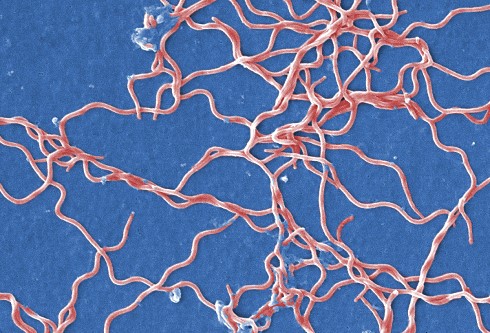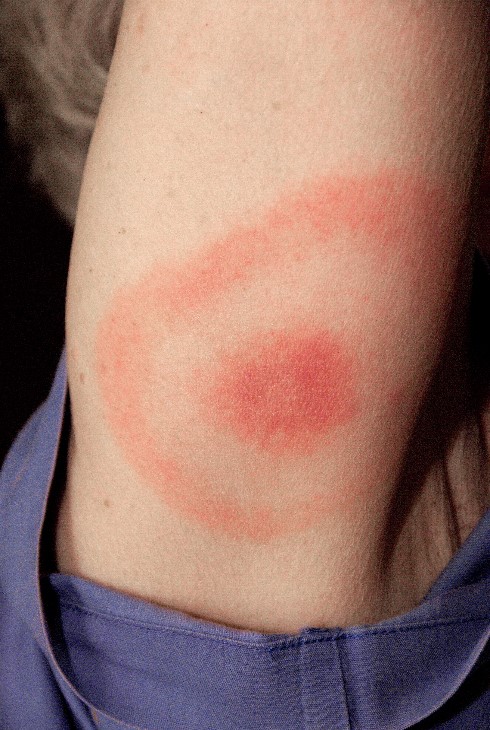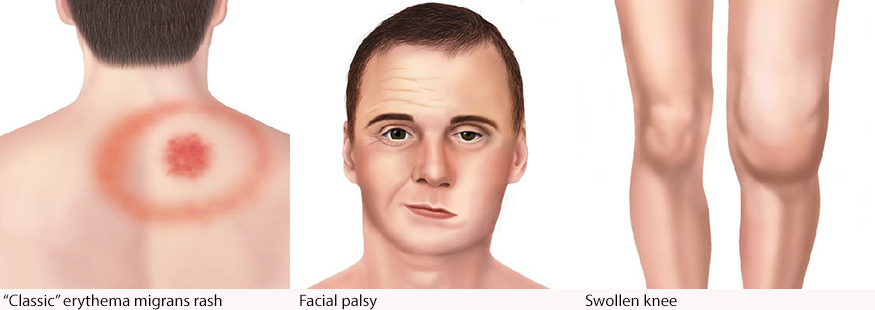Lyme disease is an infection caused by the bacterium Borrelia burgdorferi, which is transmitted in Indiana by the bite of an infected blacklegged tick (Ixodes scapularis). Lyme disease is the most commonly reported tick-borne disease in Indiana and in the United States. Typical symptoms include fever, headache, fatigue, and a skin rash with a characteristic “bulls-eye” appearance. If left untreated, infection can spread to joints, the heart, and the nervous system.

Borrelia burgdorferi. Photo: Janice Haney Carr, Centers for Disease Control and Prevention.
- Transmission
The Lyme disease bacterium is transmitted in Indiana by the blacklegged tick (Ixodes scapularis). In most cases, an infected tick must be attached to the body for at least 36–48 hours before the bacterium can be transmitted. Most humans are infected through the bites of immature ticks called nymphs, which are extremely small (less than 2 mm) and difficult to see. In Indiana, nymphs are most active during spring and summer. Adult ticks, which are most active during the late summer and fall, can also transmit Lyme disease bacteria.
- Signs and Symptoms
Signs and symptoms of Lyme disease usually appear within 3–30 days of a bite from an infected tick. People in the early stages of illness can experience flu-like symptoms, such as:
- Fever
- Chills
- Headache
- Fatigue
- Muscle and joint aches
- Swollen lymph nodes
Approximately 70–80% of Lyme disease patients will experience a characteristic “bulls-eye” or erythema migrans (EM) skin rash. The EM rash expands gradually over a period of days and may reach a diameter of 12 inches or more. It may feel warm to the touch, but is rarely itchy or painful. EM rashes typically first appear at the site of the tick bite, but may appear on any area of the body.

Erythema migrans rash. Photo: James Gathany, Centers for Disease Control and Prevention.
Later signs of Lyme disease can include arthritis with severe joint pain and swelling, complications affecting the nervous system (e.g., facial palsy), and heart problems (e.g., irregular heartbeat).

Graphic: Centers for Disease Control and Prevention.
- Diagnosis
Diagnosis of Lyme disease is based upon the patient’s signs and symptoms, a history of possible exposure to ticks, and appropriate laboratory testing. Early recognition of symptoms is important for prompt diagnosis and treatment. If you think that you have Lyme disease, contact your health care provider.
People who have removed an attached tick sometimes wonder if they should have it tested for tick-borne diseases. Although some laboratories offer this testing, IDOH does not recommend it. If the tick tests positive, it does not necessarily mean that you have been infected; if the tick tests negative, it may provide a false sense of security because you may have been unknowingly bitten by a different tick that was infected.
- Treatment
Patients treated with appropriate antibiotics in the early stages of Lyme disease usually recover rapidly and completely. Most patients are treated for Lyme disease with a short course of oral antibiotics; however, intravenous treatment may be needed for more severe cases, such as people with complications affecting the heart or nervous system.
Post-Treatment Lyme Disease Syndrome
Some patients may continue to have non-specific symptoms such as fatigue, pain, and joint and muscle aches that persist for months after treatment. This is called post-treatment Lyme disease syndrome, or PTLDS. The cause of PTLDS is unknown.
- Prevention
There is currently no Lyme disease vaccine available for human use. The best way to prevent Lyme disease is to avoid tick bites. Please see our tick prevention page for more information.
For more information about Lyme disease, please visit the CDC Lyme Disease webpage.
- Maps and Statistics
For Lyme disease maps and statistics in Indiana, please visit the Indiana Tick-borne Disease Surveillance dashboard.
National statistics for Lyme disease can be found at the CDC Lyme Disease Data and Statistics webpage.
- Resources
Information for Providers
For Lyme disease diagnosis, treatment, and testing information, click here.
Page last reviewed/updated: January 2025
